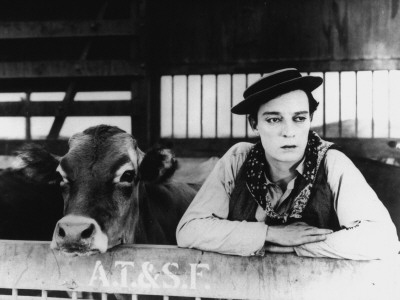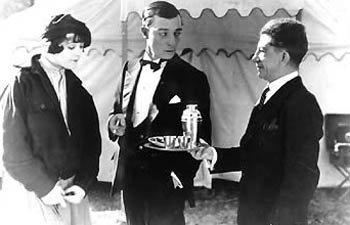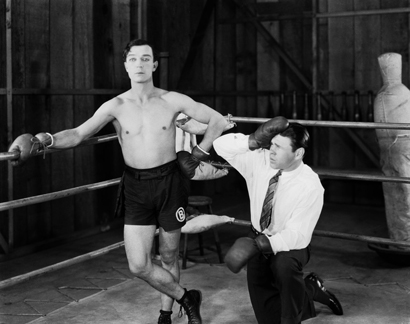
 |
|
|
|
Each and every one of Buster Keaton's silent features is a treasure, but as a series they tell the story of a film artist under constant pressure to abandon the pursuit of his unique, individualistic talent. The relative disappointment of his monumental, innovative The General was followed by the much more conventional, "safer" hit College. In 1925 Keaton's gag-oriented, almost surreal Seven Chances was not a big success either. Keaton's group of comedy collaborators broke up, and his next two pictures steered in a more character-oriented direction. Kino's Blu-ray double bill of Go West and Battling Butler is an interesting pairing of "in between" Keaton attractions. One is a likeable experiment in sentimental pathos, and the other an atypically conventional adaptation of an established stage comedy. 
Go West
As "The Great Stone Face" Buster Keaton sculpted his screen image into a blank slate onto which each viewer can project his or her feelings. No matter how hectic the action around Buster becomes, he maintains his same neutral expression as he weathers the storm. In Go West Keaton partially abandons his own rule: the face remains as calm as ever but the situations make a direct plea for the audience's sympathy. His loser hero is named "Friendless" and most of the gags concentrate on his pathetic lot in life. Even dogs don't want to associate with Friendless. When he tries to pat one, the animal just walks away. Dispossessed and cheated out of his belongings, Friendless hops a freight car to the wide-open West, to become a ranch hand. He's of course ill equipped for the work, but forms a fast bond with Brown Eyes, a cow that saves him from an angry bull. Friendless in turn rigs Brown Eyes with a pair of deer antlers, so she can ward off her pushy sisters in the dusty herd. Friendless catches the eye of the cute rancher's daughter (Kathleen Myers) but has definite difficulties forming a relationship. The main conflict arrives when the boss decides he must rush all his livestock to market, and won't make an exception for Brown Eyes. Friendless accompanies his bovine friend in the cattle car, and after a battle with outlaw rustlers ends up the only man aboard when the train rolls slowly into the Los Angeles rail yard. Unaided, he and Brown Eyes must prevent a stampede and move the herd across town to the stockyards. Fans of Keaton may be taken aback to find that Go West has none of his tinkering with cinematic concepts and no outrageously dangerous stunts. We're told that the stampede sequence is relatively tame because Keaton couldn't risk starting a real stampede in the city streets. But Keaton's physical comedy is well above the standard, and often quite inventive. Friendless gets caught in a train car filled with toppling, rolling barrels that eventually eject him out the side door. On the ranch he proves incapable of roping even a little calf, and must make do with a tiny pistol that keeps getting lost in his holster. Almost all of the humor is character oriented. Friendless and Brown Eyes become inseparable after he removes a stone from her hoof; the calm animal with the big eyes really seems to be in love with him. Only the interest of the rancher's daughter keeps friendless from losing his job, as he doesn't get along well with his fellow cowboys. A trigger-happy cowpoke accuses him of cheating, draws his gun and asks him to, "Smile". Friendless complies in the only way he can, by pushing up the corners of his immobile mouth with his fingers. While making a joke about his own screen image, Keaton references the famous confrontation from Owen Wister's novel The Virginian as well as the famous Broken Blossoms scene in which a battered Lillian Gish, too frightened to smile, uses her fingers in a similar manner. 
Keaton makes the most of the desert location's featureless flatland and empty horizon; his character seems to be isolated in limbo, Western-style. But his final stampede through the city streets is less personal and much less organized than his classic chase scenes. Many of the gags simply show barbershops and department stores overrun by the cows. Searching for something red to lead the animals to the stockyards, Friendless dons a devil costume, a choice that leads to an image of Satan leading a merry chase through downtown Los Angeles. Buster Keaton is an image unto himself, a self-contained comedy statement. When costumed in the devil outfit he seems reduced to a generic comedy figure, for a one-shot joke. Go West does not rate with Buster Keaton's more innovative features that toyed with cinematic concepts and worked out clever technical gags. It also has few of the breathlessly complex physical stunts we associate with the comedian. Yet Buster's lovable characterization wins us over completely. Friendless finds peace and companionship with Brown Eyes, and we can't help but applaud to see them reunited for the ride home in a touring car. Keaton's mechanics must really have "beefed up" that car's suspension.
Battling Butler
Even further distanced from the Keaton norm is 1926's Battling Butler, a stage play adaptation in which the comedian plays yet another spoiled rich boy. Unlike Rollo Treadway of The Navigator, Keaton's character in this show doesn't wake up to assume a heroic role until the very last scene. He's instead a fairly clueless, if lovable, character in a rigid farce. 
Born-to-the-silk Alfred Butler (Keaton) has a dutiful servant (Snitz Edwards) who does everything for him, including comb his hair and collect the ashes from his cigarettes. Alfred has little awareness of the problems of others: whenever he wants something done, he simply says, "Arrange it." His camping trip comes complete with all the comforts and luxuries of home, including ice delivery. But Alfred comes out of his shell when he meets "the mountain girl" (Sally O'Neil) and finds that his butler can't 'arrange' for their marriage. In the confusion of the moment, the girl and her two manly brothers are told that Alfred is actually Battling Butler, a boxing champion. The brothers are impressed that such a small man can be so tough in the ring. Alfred is forced to maintain this lie right through a rushed marriage. In the city where the next big fight will take place, Alfred runs into the man he's been impersonating, the real Battling Butler. Suspecting that his flirtatious wife is carrying on with Alfred, Battling agrees to allow the deception to continue. But the champion doesn't believe Alfred's story and is really setting him up for a massive beating. Battling Butler has plenty of amusing comedy material. Alfred spends a fruitless hunting day, oblivious to the multitude of rabbits, deer and other animals all around him. Hunting ducks in a canoe, he's stymied by a mallard that persists in submerging before he can point his shotgun in the right direction. Keaton is very effective as a clueless son of the rich, innocent in his every contact with the world. Only when Alfred falls in love does he become involved with deceptions and silly schemes, and to his credit his first plan of action is to do the right thing and confess all. But the coincidences keep tripping him up until he nobly resigns himself to being beaten to death in the ring, just so he won't disappoint his new wife. Alfred Butler may be a fool but he also has principles, so we're happy to see him finally prevail. 
In interviews Keaton said that he hired top New York gag writers, only to conclude that none of them could generate good ideas for physical comedy. The best material includes a scene in which the two "Mrs. Butlers" fight over a box of candy from their husband. Keaton directs it well, but his character isn't directly involved. Battling Butler's complicated story has some fine pratfalls and an impressive fight scene for a finale, but it's a stage adaptation, not a distinctive Keaton silent comedy. From his one-reel short subjects on Keaton orchestrated his physical gags into cumulative laugh patterns. A smaller gag would lead to an appropriately larger one, or return with an added twist. His Seven Chances works with the paper-thin story concept of a man pursued by 1,000 potential brides, but Keaton finds unlimited variations on the joke. The idea of a man faced with unavoidable matrimony is ultimately reduced to an image of Buster dodging an avalanche of tumbling boulders. Conceived for the screen, Keaton's comedies couldn't be adapted for a stage. Battling Butler sees Buster Keaton altering his screen character slightly to serve the pre-existing story. It's a fine farce, but compared to classic Keaton it is also a relatively tame and conventional exercise. One notable fan is Martin Scorsese, who was impressed by the realism of the final boxing match. Kino's Blu-ray of Go West and Battling Butler has been mastered from original nitrate prints archived in the Library of Congress. Picture quality is very good for both features. Full music scores are provided by Eric Beheim and Robert Israel, respectively. Kino's disc producer Bret Wood has obtained an hour-long audio recording featuring Keaton working out a proposed script for an episode of TV's Wagon Train, as well as screenplay excerpts from Keaton's unproduced Battling Butler remake, planned for the late 1940s. Galleries of production stills and photos from the 1922 stage version of Battling Butler are included as well.
On a scale of Excellent, Good, Fair, and Poor,
Blu-ray rates:
Reviews on the Savant main site have additional credits information and are often updated and annotated with reader input and graphics. Also, don't forget the 2011 Savant Wish List. T'was Ever Thus.
Review Staff | About DVD Talk | Newsletter Subscribe | Join DVD Talk Forum |
| ||||||||||||||||||